2011 Ford Shelby GT500 – Click above for high-res image gallery
Ever since Ford introduced the modern Shelby GT500 four years ago, almost no one has complained about the prodigious power levels produced by its supercharged 5.4-liter V8. With as much as 540 horsepower and 510 pound-feet of torque in the 2010 model, there was no shortage of grunt. No, the issue was an excess of mass.
Before the contemporary GT500 was born, Ford had a blown aluminum block 5.4-liter V8 in the short lived GT supercar. However, when the engineers at Ford's Special Vehicle Team developed the GT500, they opted to mount the GT's cylinder heads on the cast iron block used in the big F-Series pickup trucks. After debuting a visual refresh for the Mustang a year ago, Ford has spent the last two months announcing fresh new powertrains for the base and GT models. That process has now come full circle with SVT rolling out a heart transplant for the Shelby GT500. The 2011 model finally has the aluminum powerplant we all wanted when it debuted, and the effect is absolutely en-lightening. Read on to find out more.
Live photos by Sam Abuelsamid / Copyright ©2010 Weblogs, Inc.
The SVT engineers actually had a reason for going with the iron block in the first place. Mustangs like the GT500 and its Cobra ancestors often end up being heavily modified for use at drag strips and race tracks, and the SVT crew wanted to make sure the standard block could stand up to the rigors of those significantly higher outputs. They chose not to use an aluminum block until they had a chance to develop one with the same strength as the iron version, and that time has now come.
We recently had a chance to sit down with GT500 chief nameplate engineer Jamal Hameedi in his office at SVT's headquarters to learn more about what's new for 2011. Switching to an aluminum block was a bit more complicated than simply digging out the casting molds that were used for the GT. The engine in that 200+ mph supercar used a dry sump lubrication system and featured iron cylinder liners. The new GT500 engine is derived from the structural design of the older block but retains the wet sump system used in other Mustangs. The real magic is something that most owners will likely never actually see.
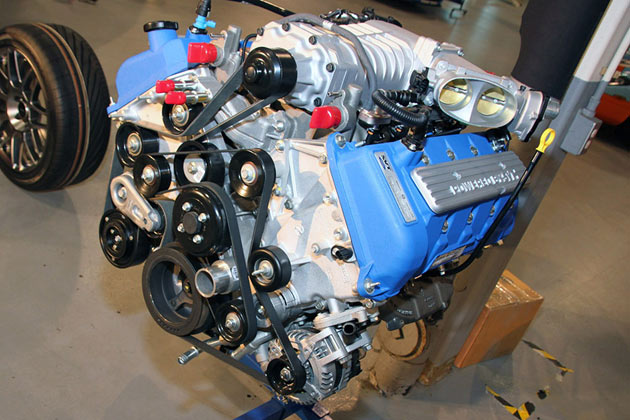
Last June we learned about an award that several Ford researchers had received for a cylinder bore coating system they developed called the Plasma Transferred Wire Arc (PTWA) process. The Ford press release at the time framed the award in terms of fuel efficiency and gave no real hint about what was about to come. It now turns out that the first production Ford to use the PTWA process will be the 2011 GT500.
Nissan actually licensed PTWA from Ford for use on its V6 engine in the GT-R.
The heart of the PTWA process involves feeding a steel wire into a device that heats it up to 35,000 degrees Fahrenheit and then sprays it onto the aluminum cylinder bores. Ford is not actually the first company to use a process like this. Similar mechanisms have been used to coat the fan blades in jet engines for a number of years. One of the primary differences is that Ford is using PTWA with a conventional steel alloy rather than some super exotic aerospace material. Ford isn't even the first automaker to use this specific coating process. That honor falls to Nissan, which actually licensed the technology from Ford for use on its V6 engine in the GT-R.
Hameedi believes that Ford has an important advantage over Nissan. Anyone that has ever used a teflon-coated pan is familiar with the problem of the non-stick coating peeling off over time. In the past BMW has also had issues with the nickasil coatings prematurely separating on some of its aluminum blocks. Getting any dissimilar materials to adhere to each other is always a problem, so the initial surface has to be specially prepared in order for the coating to have something to hang on to. Nissan licensed Ford's coating technology but used its own surface preparation process. According to Hameedi, Ford's surface preparation works so well that even after engines have gone through a full durability cycle the bores still look like new.
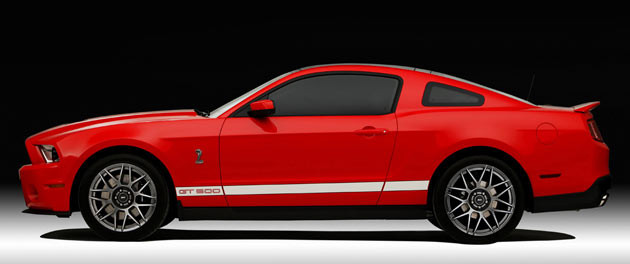
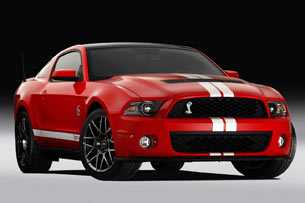
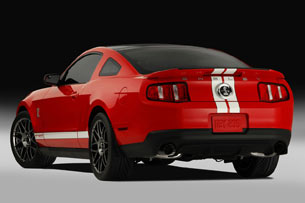
Using the PTWA process allows the block to have a thinner surface coating – only 150 microns deep – that is just as tough as one with cast or pressed-in iron or steel liners. However, using less material results in lower weight. According to Hameedi, the GT500 block is 8.5 pounds lighter than the sleeved GT version. Overall, the complete engine is 102 pounds lighter than the 2010 cast iron engine. The steel coating has also helped Ford reduce the internal friction of the engine, aiding both efficiency and power production.
Hameedi explained that some drag racers complained of power drop off on humid summer days, which was attributed to reduced heat transfer efficiency. SVT addressed this with a larger intercooler that helps the engine deliver more consistent power over its entire operating range as well as under different environmental conditions. Hameedi tells Autoblog that the new aluminum block engine should be able to survive "at least" as much maximum power in modified form as the iron block equivalent. Also aiding breathing is a larger exhaust system with 2.75 inch header pipes like those on the new 5.0-liter in the Mustang GT. Out of the box, the new powerplant delivers 10 more horsepower bringing the tally up to 550 hp with the same peak torque of 510 pound-feet. Eighty percent of that torque is available everywhere between 1,750 rpm and 6,250 rpm.
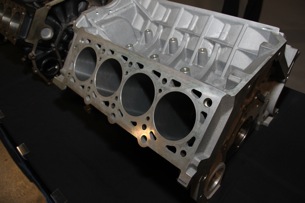
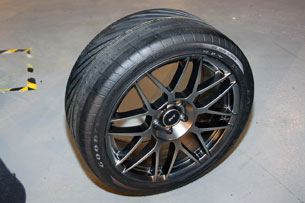
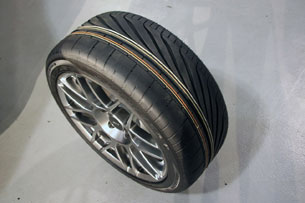
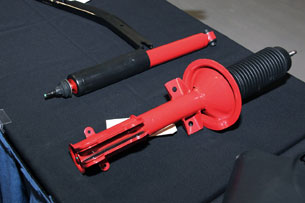
For 2011, Hameedi tells us "We're at the top of the power heap, we're the fastest accelerating vehicle, so this really wasn't about going any faster in a straight line. This was about improving the weight distribution and handling of the vehicle." The new engine contributed to a 120 pound overall weight reduction with most of that coming off the front axle. Most of the rest of the weight loss came from new lighter weight wheels that are part of the SVT Performance Package. The front wheels that come with the Performance Package remain 19 inches in diameter but are 4.7 pounds lighter. The rears grow to 20 inches but are still 2.8 pounds lighter. Cutting unsprung mass is never a bad thing when it comes to both ride quality and handling. Along with the extra rear grip provided by the larger Performance Package wheels and tires, SVT has added a 3.73:1 rear axle ratio.
The 2011 GT500 is three seconds faster around a certain un-named northern California racetrack.
Like other 2011 Mustangs, the GT500 gets a new electric power assist steering (EPAS) system that Hameedi describes as "extremely precise." At parking lot speeds, he describes the steering effort as Lincoln-like but it rapidly builds up as you drive more aggressively and it supposedly has excellent on-center feel, something that is often tough to achieve with EPAS. We'll have to wait a few more months to find out just how precise that is since we won't get to drive the car until Spring.
Getting any high-powered car to accelerate, stop or turn is highly dependent on the adhesion between the tire and the road surface, especially when it's wet. SVT has adopted the latest generation Goodyear F1 supercar tires for the 2011 GT500, which Hameedi says are "a major step" beyond the previous version in both wet and dry grip. With the reduced mass on the front axle, SVT has also modified the spring and damper rates on both base and Performance Package models. The latter version gets 20.5-percent stiffer front springs and 9.5-percent tighter rears that also bring the front end 11 millimeters closer to the road and the rear 8 mm lower.

One of the main criticisms of the Mustang convertible ever since the S197 debuted for 2005 (actually ever since pretty much forever) is a lack of structural integrity. Because of that flexibility, the 2010 model GT500 convertible was actually considered more of a cruiser model and was thus tuned more for ride comfort than handling. Thus the old convertible was only available with 18-inch wheels. For 2011, SVT took the lead on developing an upgraded body structure for the convertibles that should help keep the corners of the car from moving relative to each other. The effort was successful enough that the changes are being implemented across the board on all 2011 Mustang convertibles. The 2011 GT500 convertible also gets bumped up to the 19-inch wheels and offers handling that is supposedly much closer to the coupe without degrading the ride comfort.
For those who want the sun to shine but still want the extra stiffness of the coupe, the GT500 is now available with the glass roof that has been available on regular Mustangs for the past two years.
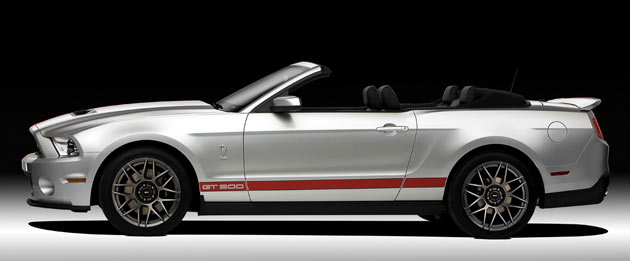

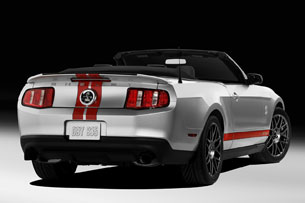
Regardless of the roof type, Hameedi tells us that the GT500 has "a very different driving experience driving an '11 from a '10, they're much more nimble, they feel more alive, the steering is quicker." The straight-line acceleration was improved by about 1/10th of second, but overall drivability and handling are said to be vastly improved. The upgrades are far more apparent on a road course than they are at the drag strip. According to SVT spokesman Patrick Hespen, the 2011 GT500 model is three seconds a lap faster than the 2010 around a certain un-named 2.3-mile-long, northern California racetrack that happens to play host to a big historic racing event every August. Closer to home at Grattan raceway in west Michigan, the 2011 GT500 is also about 2.5-3 seconds a lap faster. Given the relatively modest power increase, those are some big numbers.
The Performance Package also gets some modest visual differentiators including narrower racing stripes down the center of the body along with the new wheel design. Inside the car, the shift knob on the Performance Package model lacks the stripes found on the base model.
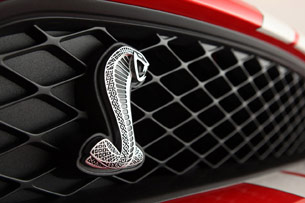
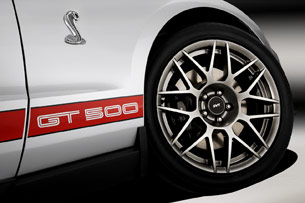
While most GT500 drivers are unlikely to be too concerned about fuel efficiency, it is a political and commercial reality that Ford does have to deal with. The EPA rated the 2010 GT500 at 14 mpg city and 22 mpg highway and slapped a $1,000 gas guzzler tax on the hood. The addition of EPAS, reduced mass and reduced friction all helped to improve the 2011 GT500's EPA numbers to 15 and 23 mpg and cleared the GT500 of the dreaded guzzler label.
Finally, just like the new 2011 V6 and GT Mustangs, the GT500 will go into production this Spring with an on-sale date before Summer. We'll be anxiously awaiting our first time behind the wheel of the 2011 Ford Shelby GT500, but until then you can peruse Ford's official press release for more details and browse our high-res image galleries.
Live photos by Sam Abuelsamid / Copyright ©2010 Weblogs, Inc.
2011 FORD SHELBY GT500 GOES LIGHTWEIGHT WITH ALUMINUM ENGINE, OFFERS ULTIMATE IN HANDLING
DEARBORN, Mich., Feb. 8, 2010 – Ford's Special Vehicle Team (SVT) engineers are taking high performance to a new level with the 2011 Ford Shelby GT500, resulting in a car that has an all-new aluminum-block engine, even better driving dynamics and handling, improved fuel economy and more horsepower than ever.
"The SVT team continues to push the performance standards of the Shelby to even higher levels and better refinement," said Jost Capito, director of global performance vehicles and motorsports business development. "All the changes we made reflect a desire for even better handling and outstanding driving dynamics – from weight savings to improved balance."
Weight savings, new technology headline all-new aluminum engine
The 2011 Shelby GT500 is powered by an all-new aluminum-block 5.4-liter supercharged V-8 engine, which produces 550 horsepower and 510 ft.-lb. of torque, a 10 horsepower increase versus the 2010 model. The engine also is 102 pounds lighter than its predecessor, delivering a better power-to-weight ratio, improved fuel economy, acceleration, handling and steering precision.
"Cutting weight to improve performance is a tradition among hot rodders," said Carroll Shelby, founder of Shelby American. "It might not be as sexy as adding more horsepower or bigger brakes, but shaving pounds off of a car is the single smartest move you can make."
The new engine uses state-of-the-art Plasma Transferred Wire Arc (PTWA) liner coating, a process that applies a 150-micron composite coating that contains nanoparticles on the internal surfaces of engine cylinder bores, replacing cast-iron liners typically used in aluminum engine blocks. The Intellectual Property Owners Education Foundation honored the inventors of the Ford-patented PTWA technology with the 2009 National Inventor of the Year Award.
This is the first Ford application of the technology, and it offers improved overall performance and durability, along with functional benefits of reduced friction between piston rings and cylinder bores, improved heat transfer due to increased surface contact area and a weight savings of 8.5 pounds compared to a typical steel-sleeved aluminum block. A mechanical roughening process provides higher material adhesion for the spray coating.
The PTWA process uses air and electricity to create a plasma jet of 35,000 degrees Fahrenheit, which melts a steel wire that is fed into a rotating spray gun. Using atomized air, the melted steel wire is blown into a specially machined surface of the aluminum-block engine cylinder bore. In the process of melting and applying the metal to the surface, the steel wire oxidizes, creating a composite coating consisting of both iron and iron oxide.
"Ford's Global Research and Advanced Engineering looks to all industries for advanced technologies – and this comes from aerospace. It's the same technology you would find on aircraft engines," said Glenn Jorgensen, SVT powertrain team leader. "We've invented a coating as a replacement for cast iron that delivers improvements in power and performance and fuel economy."
The new engine also has its roots in the iconic Ford GT. The new 5.4-liter engine is an evolution of the GT engine, with improved block structure through the use of a unique bulkhead chilled process and six-bolt billet main bearing caps. This new advanced engine will exceed Ford GT performance with its traditional supercharger technology.
"The Ford GT has solidified itself as one of the world's most coveted supercars. To make improvements to the engine from this supercar and make it available in a Mustang is impressive," said Kerry Baldori, SVT global performance vehicle chief functional engineer. "The aluminum-block engine is robust and strong enough to produce the performance numbers and durability our customers demand."
Increased power and increased fuel economy
The 2011 Shelby GT500 combines power and fuel economy into one impressive package. This 2011 Shelby GT500 will be the first modern Shelby without the gas guzzler tax, thanks to the EPA-projected 23 mpg highway and 15 mpg city it will deliver. This is up from 22 mpg highway and 14 mpg city for the 2010 model.
The 5.4-liter V-8 achieves 80 percent of its torque between 1,750 and 6,250 rpm, giving the car a higher level of performance feel. A larger two-row intercooler for the supercharger system has 40 percent more cooling capacity, helping to make power more consistent in higher ambient conditions.
Fuel economy gains come from the new 102-pound-lighter aluminum-block engine, EPAS and detailed aerodynamic changes to the underside of the vehicle.
Dramatic performance upgrades
New for 2011 is an SVT Performance Package for enthusiasts who want even more performance out of their Shelby GT500 for racetrack-ready driving dynamics. Complete with all-new Goodyear Eagle® F1 SuperCar G: 2 tires that SVT engineers worked directly with Goodyear to develop, the car is ready to race. The tires offer superb dry traction and precise handling, complete with a race-inspired high-performance tread compound.
The optional package also offers unique styling, lighter wheels, a higher rear axle ratio and stiffer springs, and it is available on both the convertible and coupe. Data show the 2011 coupe with the SVT Performance Package is 3.0 seconds faster per lap than the 2010 Shelby GT500 on a 2.3-mile test track.
Carried over from 2010, the 2011 Shelby GT500 features AdvanceTrac®, Ford's stability control system with several options for performance. Calibration of the system for the 2011 Shelby has been uniquely tailored to each vehicle configuration (base or optional) to optimize the performance.
SVT has worked very hard to make EPAS better than the outgoing hydraulic steering system. The addition of EPAS makes for a dramatic contribution to Shelby GT500 driving dynamics, with improved torque build-up and road feel that delivers quicker and more precise steering, increased effort on the racetrack or winding roads, and reduced effort in low-speed parking maneuvers.
Slotted brake dust shields were added to improve brake cooling and handling, and a new pedal box improves clutch and pedal efforts even more. A lowered ride height of 11 millimeters in front and 8 millimeters at the rear provides a sportier attitude and improved handling.
More engine sound, less road noise For 2011, Shelby GT500 also benefits from NVH (noise, vibration and harshness) improvements. Overall road noise is reduced by 20 percent versus the 2010 Shelby. Actions undertaken to achieve this improvement include additional sound-deadening material on either side of the instrument panel, additional sound absorption behind interior trim panels, and a rear wheel arch liner to reduce noise on gravel or wet surfaces – all resulting in the driver hearing more exhaust and engine sound and less road and air noise.
The Shelby GT500 convertible model features enhanced structural rigidity, with lateral stiffness improved by 12 percent versus the 2010 model. The V-brace has been stiffened by adding gussets. The secondary crossmember also has been stiffened, while a front Z-brace has been added, connecting primary and secondary crossmembers. A-pillar stiffening foam has been added to increase rigidity.
The structural improvements to the convertible gave SVT the opportunity to be more sport-oriented in the chassis tuning, without trading comfort. Along with the chassis and structural improvements, the 2011 model also will get standard 19-inch aluminum wheels.
"One of the biggest changes for this Shelby is that the convertible acts and feels like a coupe," said Jamal Hameedi, SVT chief nameplate engineer. "Before, they had a very different character, and the convertible is taking a big step in the sportiness and handling precision area, without degrading the ride."
GT500 gets a new exhaust for 2011, roaring with an even more aggressive sound than the 2010 model. The 2.75-inch exhaust with all-new tuning helped to deliver the additional 10 horsepower.
Added convenience content
New for 2011 is an optional glass roof, providing customers with a less expensive option than a convertible and without compromising the coupe's versatility, headroom or climate-controlled environment.
The specially formulated glass also protects interior fabric material from solar radiation deterioration and discoloration by reducing solar light transmittance. To help improve acoustics and interior quietness, the glass features a layer of vinyl that reduces noise, vibration and harshness.
Other new convenience technologies include:
- With 550 horsepower and 510 ft.-lb. of torque, Ford's Special Vehicle Team (SVT) delivers the new Shelby GT500® with a 10 horsepower increase; an all-new 5.4-liter all-aluminum engine is 102 pounds lighter than the previous cast-iron engine and uses Ford-patented plasma-coating technology
- For 2011, Shelby GT500 offers EPA-projected improved fuel economy in city and highway from 2010, eliminating the gas guzzler tax
- The addition of Electric Power Assist Steering (EPAS), a new optional SVT Performance Package, enhanced convertible rigidity and a lowered ride height contribute to improved driving dynamics and handling
DEARBORN, Mich., Feb. 8, 2010 – Ford's Special Vehicle Team (SVT) engineers are taking high performance to a new level with the 2011 Ford Shelby GT500, resulting in a car that has an all-new aluminum-block engine, even better driving dynamics and handling, improved fuel economy and more horsepower than ever.
"The SVT team continues to push the performance standards of the Shelby to even higher levels and better refinement," said Jost Capito, director of global performance vehicles and motorsports business development. "All the changes we made reflect a desire for even better handling and outstanding driving dynamics – from weight savings to improved balance."
Weight savings, new technology headline all-new aluminum engine
The 2011 Shelby GT500 is powered by an all-new aluminum-block 5.4-liter supercharged V-8 engine, which produces 550 horsepower and 510 ft.-lb. of torque, a 10 horsepower increase versus the 2010 model. The engine also is 102 pounds lighter than its predecessor, delivering a better power-to-weight ratio, improved fuel economy, acceleration, handling and steering precision.
"Cutting weight to improve performance is a tradition among hot rodders," said Carroll Shelby, founder of Shelby American. "It might not be as sexy as adding more horsepower or bigger brakes, but shaving pounds off of a car is the single smartest move you can make."
The new engine uses state-of-the-art Plasma Transferred Wire Arc (PTWA) liner coating, a process that applies a 150-micron composite coating that contains nanoparticles on the internal surfaces of engine cylinder bores, replacing cast-iron liners typically used in aluminum engine blocks. The Intellectual Property Owners Education Foundation honored the inventors of the Ford-patented PTWA technology with the 2009 National Inventor of the Year Award.
This is the first Ford application of the technology, and it offers improved overall performance and durability, along with functional benefits of reduced friction between piston rings and cylinder bores, improved heat transfer due to increased surface contact area and a weight savings of 8.5 pounds compared to a typical steel-sleeved aluminum block. A mechanical roughening process provides higher material adhesion for the spray coating.
The PTWA process uses air and electricity to create a plasma jet of 35,000 degrees Fahrenheit, which melts a steel wire that is fed into a rotating spray gun. Using atomized air, the melted steel wire is blown into a specially machined surface of the aluminum-block engine cylinder bore. In the process of melting and applying the metal to the surface, the steel wire oxidizes, creating a composite coating consisting of both iron and iron oxide.
"Ford's Global Research and Advanced Engineering looks to all industries for advanced technologies – and this comes from aerospace. It's the same technology you would find on aircraft engines," said Glenn Jorgensen, SVT powertrain team leader. "We've invented a coating as a replacement for cast iron that delivers improvements in power and performance and fuel economy."
The new engine also has its roots in the iconic Ford GT. The new 5.4-liter engine is an evolution of the GT engine, with improved block structure through the use of a unique bulkhead chilled process and six-bolt billet main bearing caps. This new advanced engine will exceed Ford GT performance with its traditional supercharger technology.
"The Ford GT has solidified itself as one of the world's most coveted supercars. To make improvements to the engine from this supercar and make it available in a Mustang is impressive," said Kerry Baldori, SVT global performance vehicle chief functional engineer. "The aluminum-block engine is robust and strong enough to produce the performance numbers and durability our customers demand."
Increased power and increased fuel economy
The 2011 Shelby GT500 combines power and fuel economy into one impressive package. This 2011 Shelby GT500 will be the first modern Shelby without the gas guzzler tax, thanks to the EPA-projected 23 mpg highway and 15 mpg city it will deliver. This is up from 22 mpg highway and 14 mpg city for the 2010 model.
The 5.4-liter V-8 achieves 80 percent of its torque between 1,750 and 6,250 rpm, giving the car a higher level of performance feel. A larger two-row intercooler for the supercharger system has 40 percent more cooling capacity, helping to make power more consistent in higher ambient conditions.
Fuel economy gains come from the new 102-pound-lighter aluminum-block engine, EPAS and detailed aerodynamic changes to the underside of the vehicle.
Dramatic performance upgrades
New for 2011 is an SVT Performance Package for enthusiasts who want even more performance out of their Shelby GT500 for racetrack-ready driving dynamics. Complete with all-new Goodyear Eagle® F1 SuperCar G: 2 tires that SVT engineers worked directly with Goodyear to develop, the car is ready to race. The tires offer superb dry traction and precise handling, complete with a race-inspired high-performance tread compound.
The optional package also offers unique styling, lighter wheels, a higher rear axle ratio and stiffer springs, and it is available on both the convertible and coupe. Data show the 2011 coupe with the SVT Performance Package is 3.0 seconds faster per lap than the 2010 Shelby GT500 on a 2.3-mile test track.
Carried over from 2010, the 2011 Shelby GT500 features AdvanceTrac®, Ford's stability control system with several options for performance. Calibration of the system for the 2011 Shelby has been uniquely tailored to each vehicle configuration (base or optional) to optimize the performance.
SVT has worked very hard to make EPAS better than the outgoing hydraulic steering system. The addition of EPAS makes for a dramatic contribution to Shelby GT500 driving dynamics, with improved torque build-up and road feel that delivers quicker and more precise steering, increased effort on the racetrack or winding roads, and reduced effort in low-speed parking maneuvers.
Slotted brake dust shields were added to improve brake cooling and handling, and a new pedal box improves clutch and pedal efforts even more. A lowered ride height of 11 millimeters in front and 8 millimeters at the rear provides a sportier attitude and improved handling.
More engine sound, less road noise For 2011, Shelby GT500 also benefits from NVH (noise, vibration and harshness) improvements. Overall road noise is reduced by 20 percent versus the 2010 Shelby. Actions undertaken to achieve this improvement include additional sound-deadening material on either side of the instrument panel, additional sound absorption behind interior trim panels, and a rear wheel arch liner to reduce noise on gravel or wet surfaces – all resulting in the driver hearing more exhaust and engine sound and less road and air noise.
The Shelby GT500 convertible model features enhanced structural rigidity, with lateral stiffness improved by 12 percent versus the 2010 model. The V-brace has been stiffened by adding gussets. The secondary crossmember also has been stiffened, while a front Z-brace has been added, connecting primary and secondary crossmembers. A-pillar stiffening foam has been added to increase rigidity.
The structural improvements to the convertible gave SVT the opportunity to be more sport-oriented in the chassis tuning, without trading comfort. Along with the chassis and structural improvements, the 2011 model also will get standard 19-inch aluminum wheels.
"One of the biggest changes for this Shelby is that the convertible acts and feels like a coupe," said Jamal Hameedi, SVT chief nameplate engineer. "Before, they had a very different character, and the convertible is taking a big step in the sportiness and handling precision area, without degrading the ride."
GT500 gets a new exhaust for 2011, roaring with an even more aggressive sound than the 2010 model. The 2.75-inch exhaust with all-new tuning helped to deliver the additional 10 horsepower.
Added convenience content
New for 2011 is an optional glass roof, providing customers with a less expensive option than a convertible and without compromising the coupe's versatility, headroom or climate-controlled environment.
The specially formulated glass also protects interior fabric material from solar radiation deterioration and discoloration by reducing solar light transmittance. To help improve acoustics and interior quietness, the glass features a layer of vinyl that reduces noise, vibration and harshness.
Other new convenience technologies include:
- Standard HID (high-intensity discharge) headlamps
- MyKey™ programmable vehicle key
- Integrated spotter mirror
- Fold-down rear headrests


Sign in to post
Please sign in to leave a comment.
Continue